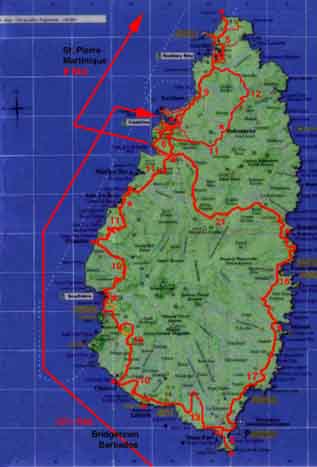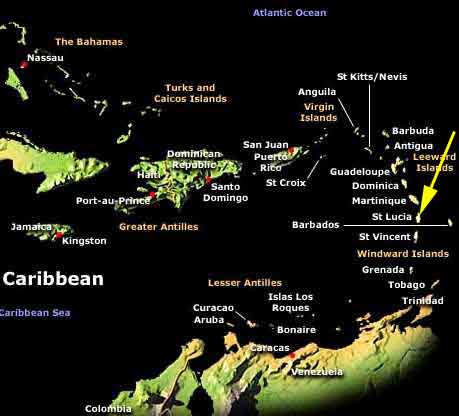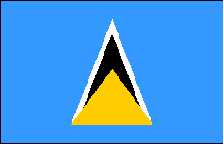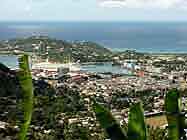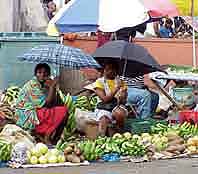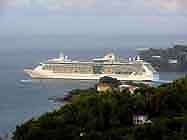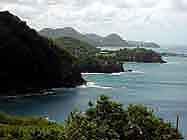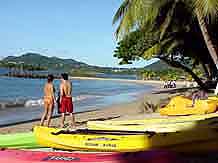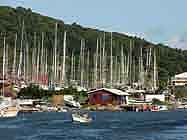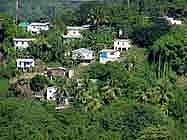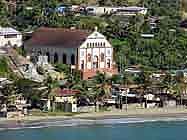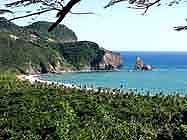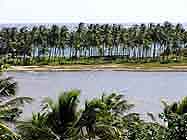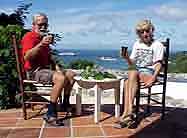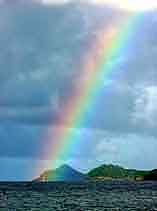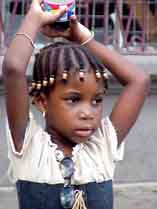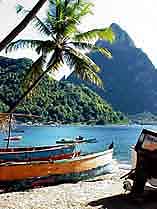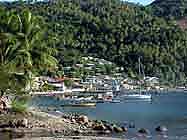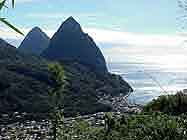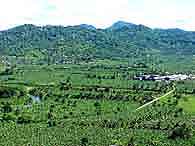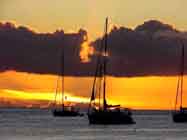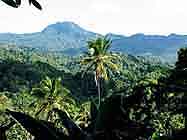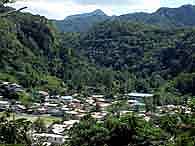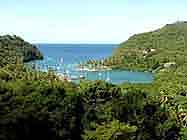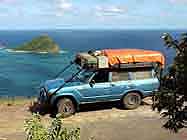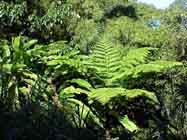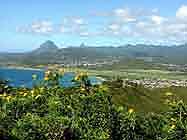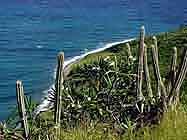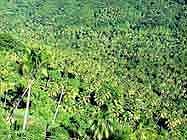![]()
Enjoy some pictures of the worldrecordtour taken in St. Lucia
|
|
click a picture to see details |
|
|
|
|
|
| View over the picturesque port of the capital Castries | Colorful Saturday market in Castries |
Cruise Ship entering the harbor of
Castries |
|
| St. Lucia - The
Paradise Island
|
|||
| Small sand beaches interrupt the tropical hills on the Northwest Coast | Rodney Bay is one of the most beautiful beaches in St. Lucia | Sailing boats from all over the world dock in the Marina of Rodney Bay | |
| With little sleep, after twelve hours of rough sea, we enter at 6am together with three huge Cruise Ships the port of Castries. Three hours later, finally the Customs arrives and we may drive our LandCruiser out of the vessel. Just parked, one of the not-uniformed guys approaches us and wants to have handed over our car keys. Of course, we refuse. Not in the wildest dreams we are ready to give the key to our entire home to a complete stranger. The guy is not happy however. He gets excited, then louder and more and more persistent. He does not give us any chance to explain. We think he might calm down in a while, and walk away, heading first to the Immigration Department. There, a middle-aged woman looks at us in not a too friendly manner, as we cannot show her a return ticket to our home country, which is required in all the Caribbean Islands. We have to explain her the full length of our story and that we arrived by sea together with our car and will leave in two to three weeks on the same way again. Finally, we get stamped a surprisingly 42 days stay into our passports. Then, we proceed to the Customs Comptroller regarding the clearance of our Landcruiser. He also does not treat us too friendly and explains that - despite that the St. Lucian cabinet agreed to let us into their country without paying neither duty nor placing a bond - he still has to insist on such a guarantee, which he figured out to be US$3'500 - to assure that we will re-export our car again. Of course, we slowly start to worry about our future in this "Paradise" and call the Ministry of Tourism, to whom we explain the whole situation. The response is that they would sort it out.
|
|||
| Modest houses of wood nestle on the steep hills above Castries | Impressive church of the fishing village of Dennery at the East Coast | Lonely Fond d'Or Bay on the rough Atlantic Coast | |
| An hour later we get the message that the Ministry of Tourism will place the requested bond in its own name and that they will give the order to an agent who will do the necessary paper work. To calm us down, two ladies - Mrs. Deepa, responsible for us at the Ministry of Tourism, and her colleague - invite us to a wonderful lunch at a nice harbor restaurant what we appreciate after all the excitement. On our return to the office, it shows that in the meantime our "key guy" complained at the harbor manager about us not wanting to hand over our car keys, who on his turn threats us to confiscate the car with all its content in case we do not cooperate. Slowly but steadily we find the people of this "Paradise" Island not anymore so nice. And again and again we hear the same phrases: " It's the rule - it's the law - these are the regulations, and this is St. Lucia!" In the meantime, our rusty vessel "MV Admiral Bay" left again for Barbados taking away the last opportunity to escape this inhospitable place again. What shall we do? With not the best feelings at all we finally decide to give in as the harbor manager promises that he personally guarantees that he will keep the key and that there will be no pilfering during the night. As we are not able to sleep in our car and we have been walking around in the same clothes since two days, we want to fetch clean ones and our toothbrushes from our vehicle. But this becomes a problem too. The Port Director has to ask the Customs Comptroller - who is in a meeting - if he can allow it. But his officer, who would be in charge to make a protocol of the toothbrushes, underpants and T-shirts we want to take with us, already left for home. Therefore, we do not get the permission to take anything out of our car and thus will have to walk around smelly for another day. We have experienced a lot during our travels, but never such nonsense and are really more than fed up - not only about our own smell.
|
|||
| A scene like in the South Pacific | Celebrating New Years Day 2004 in "our" villa above Castries | Winners of the Martinique sailing regatta enter Rodney Bay | |
| To make it short: The next morning we find our Landcruiser untouched and the agent, ordered by the Ministry of Tourism, starts with the necessary customs procedures. The situation has calmed down and mid-afternoon, a bolded customs officer inspects our car randomly and shows his appreciation for our adventure. Our thoughts of revenges start to disappear slowly, even if we still do not know, what kind they would have been. It seems to us that in these "Paradise" countries we first have to shock a low rank employee in order to get the attention of a superior person. Only then, they start to deal with the case and one gets a normal treatment again. We have the impression that the whole port authorities are simply overrun by the masses of cruise ship tourists and have become so inflexible that a special and individual case as ours completely surpasses their competences. But our frustration is not finished yet. In the evening we get presented a port fee bill of US$464 (!) for "unloading" our LandCruiser, despite that Emil drove himself the car out of the vessel and parked it. But "this is the law!" After the intervention of the Ministry of Tourism, where we complain about it, the amount is reduced to US$330 - but we still are shocked, particularly because we had to learn that leaving the island, the same fees will apply again. Where did we end? How may hell look like if this is paradise? With all that anger, at least we learnt one valuable lesson: Before shipping to new destinations, we want to know exactly what fees we are expected to pay. So more phone calls will be necessary, raising considerably the budget of the logistics, consisting already now of 145 overseas calls and 49 faxes.
|
|||
| Intensive rainbow over the Caribbean Sea | One of the many traditional hairstyles of the Caribbean | Picture book view of one of the two "Pitons" in Soufrière | |
| Well, also our tempers calm down during the next days and we try to see also the positive sides of this Caribbean island. No doubt, being able to live in an offered "dream" villa - not rented out at the time being - overlooking the capital Castries, the neighbor island of Martinique and the surrounding hills, add to our feeling of luck. And, apart from the not very friendly people in the port, we find the islanders nice and welcoming, even if they definitely lack the natural charm of the "Bajans" - the people from Barbados. We can deal with the few drug-addicted Rastafarians, who approach us again and again. But over all, it is the nature, which impresses us: The chain of steep coastal hills of volcanic origin, overgrown with dense tropical vegetation, huge ferns, bamboos and palm trees, separated by jungle rivers, banana plantations and quiet fishing villages in the plains. We have to admit that this tropical island up to know is the most beautiful one of the visited Windward Islands. The most impressive part is around the village of Soufrière - about 40 km South of Castries - where the most beautiful and most famous land mark of the whole Caribbean appears: The two majestic volcanoes - named "Pitons" - which rise directly from the sea approximately 300 meters vertically towards the sky. Again and Again, we stop at all the viewpoints, to enjoy the outstanding views. There is only one thing that upsets us: The aggressive and persistent souvenir vendors! Luckily, this negative outbreak of mass tourism is not found along the East and South Coast. There, we encounter very little traffic and find ourselves surrounded by untouched nature and solitude - exactly the way we like it. And the quiet Cape Moule à Chique in the South offers another outstanding panorama: We enjoy a sweeping view over the prominent silhouette of the mountains in the West and the fringed Atlantic Coast in the East at the same time.
|
|||
| Fishing village of Soufrière surrounded by an ocean of palm trees | The "Pitons", the most prominent landmark of the Caribbean, and the village of Soufrière |
Banana plantations in the Roseau Valley as far as the eye can see | |
| Of course, also in St. Lucia lure "picture book" beaches, although not in that big number as in Barbados. Marigot Bay - where the film "Dr. Dolittle" was made - is the most prominent and most picturesque one. Steep hills, covered with dense tropical vegetation, meet a small sandy bay with palm trees swaying in the wind. A few sailors have set anchor in the turquoise waters, but we do not see many bathing tourists. They are more in the Northwest, in the tourist resort area of Rodney Bay, alongside the new Marina, which can accommodate more than 1'000 yachts and which is an autonomous world itself. There are supermarkets, fresh fruit and vegetable stalls, laundries, bars, restaurants, workshops - just everything probably needed is available. We heard that some sailors never leave such a comfortable place at all. Mostly, we also find a nice spot under palm trees directly at that beach, where we watch the short-term visitors while enjoying our own exotic rum drinks. Of course, we would prefer the lonely, hidden beaches on the rougher Atlantic Coast in the East. But unfortunately, they are all very hard to get to. We had to turn back a few times, because the steep and completely washed out accesses are impracticable also by 4x4 due to the lack of maintenance of the tracks. And hotel resorts own many other beaches - with payable access - even if actually in the whole Caribbean all beaches are supposed to be public. A local told us once: "Here in St. Lucia nobody is doing a favor unless for money", or the other way round: "If you want to come to paradise, you have to pay for"!
|
|||
| Yachts and a tropical sunset in Rodney Bay | Endless green in St. Lucia's hinterland | Anse La Raye, surrounded by impressive mountains | |
| Actually, we already wanted to continue to Martinique before Christmas. But it did not work out. Despite that Martinique is only 34 km away; there are very little reasonable shipping opportunities. Twice a week, there is a high-speed ferry, which can transport 80 cars and 400 passengers. But here in St. Lucia there is no appropriate ramp for loading and unloading cars. Then, there is a weekly connection by two big shipping lines, where only containerized transport is possible and thus, the costs for the small distance would be US$1'500! Once again it is just luck which helps us: We learn of a sand pontoon that transports high quality construction sand from Martinique to St. Lucia and returns afterwards empty, unfortunately not to the capital Fort-de-France, but to St. Pierre in the North of the island. We make contact with the owner in Martinique, who agrees immediately to take our LandCruiser and us for free. Our only worries are now: Will the authorities in Martinique let us in with our car in that private terminal? "Trying is better than hesitating", is a saying. But first we need patience as the sand barge seizes all traffic during Christmas and New Year's days, which means, that we are able to enjoy a little bit longer "our" dream villa outside Castries, which really is a wonderful and special place. From our "viewpoint", we can watch all the multicolored, beautiful fireworks, which explode over Castries and which with their bright fireballs and sparks add to the enchantment of the New Years night. Who knows, if the future will give us such a wonderful chance ever again.
|
|||
| The film "Dr. Dolittle" was made in Marigot Bay | A little break at the Southeast Coast | Ferns, banana leafs and lush vegetation in the tropical rain forest | |
| It is a pity that on our departure day, we have to deal once more with a situation, which tends to destroy again our polished-up image we made in between of St. Lucia. The Ministry of Tourism wants to make us pay also the fees of US$275 for the agent, who was hired by them for placing the unnecessary bond, as well as the overtime of a customs officer, because our sand barge leaves after normal working hours from a private pier. But luckily, at the end, we can avoid both. It is hard to understand the behavior of St. Lucia's authorities. On one side, after long negotiations, the port finally eliminates the obligatory departure taxes. On the other side, the Ministry of Tourism comes with new charges. It seems that St. Lucia wants to keep its "special place" in our Caribbean history. Despite all, we are still sad to say good-bye to this island, as on January 8th at sunset, the pontoon "St. Kitts", pushed by the tug boat "Gard 1", moves to the open sea and to a new destination.
|
|||
| Sweeping view from Cape Moule à Chique in the South up to the prominent "Pitons" | Cacti and Frangipani on the
Southeast Coast |
An ocean of palm trees | |
